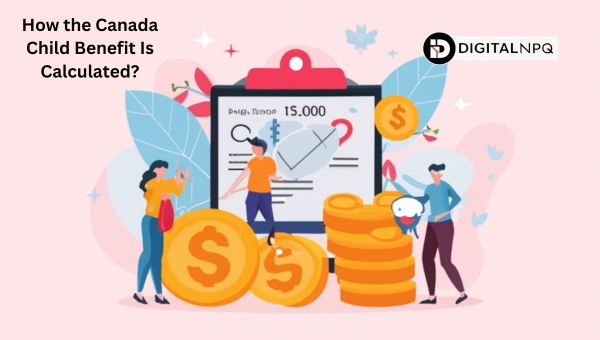Canada Child Benefit: Vital Aid Every Parent Needs to Know

Are you curious about what is Canada Child Benefit and how it can support your family? In this article, we’ll delve into the essentials of the Canada Child Benefit (CCB), including its purpose, eligibility criteria, application process, and much more.
Whether you’re a new parent or just looking to maximize your benefits, we’ve got you covered. Get ready to uncover valuable insights that can help ensure your family receives the financial support it deserves. Let’s dive in and explore everything you need to know about the CCB!
Breaking Down the Benefits of CCB
The Canada Child Benefit (CCB) is a federal program designed to provide financial support to families with children under the age of 18. Introduced in 2016, the CCB replaced the previous Canada Child Tax Benefit (CCTB).

The main aim of the CCB is to reduce child poverty and assist parents with the costs associated with raising children. This benefit is provided as a tax-free monthly payment, which is adjusted based on family income. By doing so, the program ensures that families with lower and middle incomes receive the most substantial support.
Eligibility Criteria
To qualify for the CCB, applicants must meet specific criteria:
- Residency: The applicant must be a resident of Canada for tax purposes. Additionally, they must live with a child under 18 for whom they are primarily responsible.
- Income Thresholds: The CCB is income-tested. This means the benefit amount decreases as the family’s income increases. Families with incomes below certain thresholds are eligible for higher payments, while those with higher incomes receive reduced benefits.
These criteria ensure that the CCB reaches those families who need it the most, providing essential financial support to help cover the costs of raising children.
How to Apply for the Canada Child Benefit?
Applying for the Canada Child Benefit (CCB) is a straightforward process that ensures families receive the financial support they need. To get started, you’ll need to gather some essential documents and choose the most convenient application method. Let’s dive into the details of what you need and how you can apply.

Required Documentation
When applying for the CCB, it’s important to have the right documentation ready. Here’s a list of what you’ll need:
- Proof of residency in Canada: This can be a rental agreement, utility bill, or any official document showing your address.
- Your child’s birth certificate or proof of adoption: This verifies the child’s identity and your relationship to them.
- Social Insurance Numbers (SIN): Both your SIN and your child’s SIN are required.
- Income information from the previous year: This includes tax returns and any other relevant financial documents.
Having these documents prepared will make the application process smoother and faster.
Automated Benefits Application
The Canada Revenue Agency (CRA) offers an automated service to apply for the CCB online. This method is efficient and user-friendly.
Here’s how you can do it:
- Create or log in to your CRA My Account: This is where you’ll manage your application and any future interactions with the CRA.
- Complete the online application form: Follow the prompts to provide all necessary information and upload your documents.
- Submit the application: Once everything is filled out, submit your application for review.
- Track the status of your application: You can monitor the progress of your application through your CRA My Account.
By using the automated service, you can ensure a quicker processing time and stay updated on your application’s status.
Also Read: Child Tax Increase 2024: What You Need to Know!
How the Canada Child Benefit Is Calculated?
Understanding how the Canada Child Benefit (CCB) is calculated can help families plan their finances more effectively. The calculation involves several factors, including the family’s income from a specific base year and additional provisions for children with disabilities. Let’s dive into these aspects in detail.

Base Year and Payment Period
CCB payments are calculated based on the family’s income from the previous year, known as the “base year.” The benefit period runs from July of the current year to June of the following year. For example, payments made from July 2023 to June 2024 are based on income reported in the 2022 tax return.
The calculation involves several steps:
- Determine Adjusted Family Net Income (AFNI): This is the combined net income of both parents, minus certain deductions.
- Apply Benefit Formula: The CCB amount is calculated using a formula that considers the AFNI. The benefit decreases as income increases. The formula is designed to ensure that lower-income families receive higher benefits.
- Annual Reassessment: Each year, the benefit amount is reassessed based on the latest tax information. It’s important to file tax returns on time to avoid delays in payment adjustments.
Maximum CCB Per Child
The maximum amount of CCB that can be received per child depends on the child’s age. For the 2023-2024 benefit year, the maximum payments are as follows:
- $7,437 per year for each child under 6 years old
- $6,275 per year for each child aged 6 to 17
These maximum amounts are designed to provide substantial support to families, especially those with younger children who may have higher childcare costs. The amount received decreases as family income increases, ensuring that lower- and middle-income families receive the most support.
Special Provisions for Child Disability
Families with children who have disabilities can receive additional financial support through the Child Disability Benefit (CDB). The CDB is an extra amount added to the CCB to help cover the unique costs associated with raising a child with a disability.
The additional benefits include:
- Extra financial support to assist with expenses related to the child’s disability
- Increased maximum benefit amounts to cover medical and other special needs
These special provisions aim to alleviate the financial burden on families caring for children with disabilities, ensuring they have the resources needed for their child’s well-being.
Understanding these aspects of the CCB can help families better navigate the application process and maximize their benefits.
Also Read: Capital One Payment: Easy Ways to Pay & Manage Bills
When and How Payments Are Made?
Understanding the distribution of the Canada Child Benefit (CCB) payments is crucial for effective financial planning. Let’s dive into the specifics of the payment schedule and the advantages of using direct deposit.
Payment Schedule
CCB payments are issued monthly, providing consistent financial support to families. The payment dates are typically:
- 15th of each month: This is the standard date for CCB payments.
- Adjusted for weekends and holidays: If the 15th falls on a weekend or holiday, payments are made on the last business day before.
These regular payments help families manage their budgets and meet the ongoing costs of raising children.
Direct Deposit Option
Opting for direct deposit comes with several benefits, including:
- Timely payments: Direct deposits are processed faster than checks, ensuring funds are available promptly.
- Reduced risk of lost or stolen checks: Direct deposits eliminate the need to handle physical checks, lowering the risk of loss or theft.
- Convenience: Funds are automatically deposited into your bank account, making it easier to manage your finances without additional trips to the bank.
Choosing direct deposit is a smart way to ensure that you receive your CCB payments reliably and without delay.
Post-Application Process
Once you have submitted your application for the Canada Child Benefit (CCB), it’s essential to understand what happens next.
The post-application process involves a review by the Canada Revenue Agency (CRA) and, if necessary, addressing any overpayments. Let’s dive into these steps to ensure you know what to expect.
Review by the CRA
After you submit your application, the Canada Revenue Agency (CRA) will review it to verify your eligibility and calculate the benefit amount.
This review process includes:
- Cross-referencing information: The CRA checks the details you provided against their records, including tax returns and other relevant documents.
- Confirming residency and income: They ensure you meet the residency requirements and assess your family income to determine the benefit amount.
- Requesting additional information: If needed, the CRA may ask for more documents to clarify or confirm certain details.
Understanding this review process can help you prepare and ensure all your information is accurate and complete.
Addressing Overpayments
In some cases, families might receive more CCB payments than they are entitled to. If this happens, the CRA has a process to address overpayments, which includes:
- Notification: The CRA will inform you if there has been an overpayment, providing details on the amount and reason.
- Repayment options: They will outline various repayment methods to help you return the excess funds, such as lump-sum payments or installment plans.
- Adjusting future payments: In some instances, the CRA may reduce future CCB payments to recover the overpaid amount gradually.
By keeping the CRA updated with any changes in your financial situation or family status, you can help avoid overpayments and ensure your benefits are accurate.
Related Programs
When considering child benefits in Canada, it’s important to know about additional programs that can complement the Canada Child Benefit (CCB). Let’s dive into some key programs you should be aware of.
Provincial and Territorial Benefits
In addition to the CCB, various provinces and territories offer their own child benefit programs. These programs provide extra financial support tailored to the needs of families in different regions. Here are a few examples:
- Ontario Child Benefit (OCB): Offers monthly payments to low- and moderate-income families.
- BC Family Benefit: Provides additional support to families in British Columbia.
- Alberta Child and Family Benefit (ACFB): Combines the Alberta Child Benefit and the Alberta Family Employment Tax Credit to support families with children.
Quebec Family Allowance
Residents of Quebec benefit from a unique program known as the Quebec Family Allowance. This program is designed to provide additional financial support to families with children, supplementing the federal CCB. Here are the key details:
- Eligibility: Quebec residents with children under the age of 18.
- Payment Structure: The allowance is based on the number of children and family income, with higher amounts for lower-income families.
- Special Provisions: Additional supplements are available for families with multiple children or children with disabilities.
- Application Process: Generally, no application is needed as the allowance is automatically calculated based on income tax returns filed with Revenu Québec.
Other Related Programs
Beyond provincial and territorial benefits, families might also be eligible for other programs that enhance their financial support. These include:
- Goods and Services Tax (GST) Credit: A tax-free quarterly payment that helps low- and moderate-income individuals and families offset GST expenses.
- Climate Action Incentive Payment: Provides payments to individuals and families to help them manage the costs associated with carbon pollution pricing.
- National Child Benefit Supplement (NCBS): Part of the CCB, it provides extra support to low-income families.
These programs work alongside the CCB to ensure comprehensive financial assistance for families raising children in Canada.
Also Read: COLA Increase 2024: What You Need to Know
When to Contact the CRA
When dealing with the Canada Child Benefit (CCB), certain life changes can directly impact your eligibility and payment amounts. Knowing when to contact the Canada Revenue Agency (CRA) can help you stay compliant and ensure you receive the correct benefits. Let’s explore two crucial scenarios that require notifying the CRA.
Changes in Child Care or Marital Status
Changes in your childcare arrangements or marital status can affect your CCB. It’s important to inform the CRA if:
- You start or stop sharing custody of a child.
- Your marital status changes due to marriage, separation, divorce, or the death of a spouse.
- You adopt a child or your child no longer lives with you.
These changes can influence your benefit amount, so keeping the CRA updated ensures you get the correct payments.
Moving to a New Address
Updating your address with the CRA is vital for several reasons:
- Ensures timely delivery of CCB payments.
- Keeps your tax records accurate.
- Helps maintain your eligibility status.
To update your address, you can:
- Use the CRA’s “My Account” service online.
- Call the CRA directly.
- Complete and mail Form RC325.
Keeping your information current with the CRA helps avoid any disruptions in your benefit payments and ensures that all communications reach you promptly.
FAQs
Does Canada give money for having kids?
Yes, Canada provides financial support to families with children through the Canada Child Benefit (CCB). This tax-free monthly payment helps cover the costs of raising children under 18.
Which province has the best child benefit?
Quebec is known for offering generous child benefits through its Quebec Family Allowance program. This program provides additional financial support to complement the federal CCB.
What qualifies you for welfare in Canada?
To qualify for welfare in Canada, individuals must demonstrate financial need, be residents of the province or territory where they apply, and meet specific criteria set by local social assistance programs.
Conclusion
In summary, the Canada Child Benefit (CCB) is a vital program providing financial support to families with children under 18. Understanding its eligibility criteria, application process, and calculation methods can help families maximize their benefits. Regular payments and special provisions for children with disabilities ensure comprehensive support.
Moreover, being aware of related programs and knowing when to contact the CRA can further aid in managing family finances effectively. To discover more insightful content and stay informed, be sure to explore other articles on our site. Your journey to better understanding family benefits starts here!
